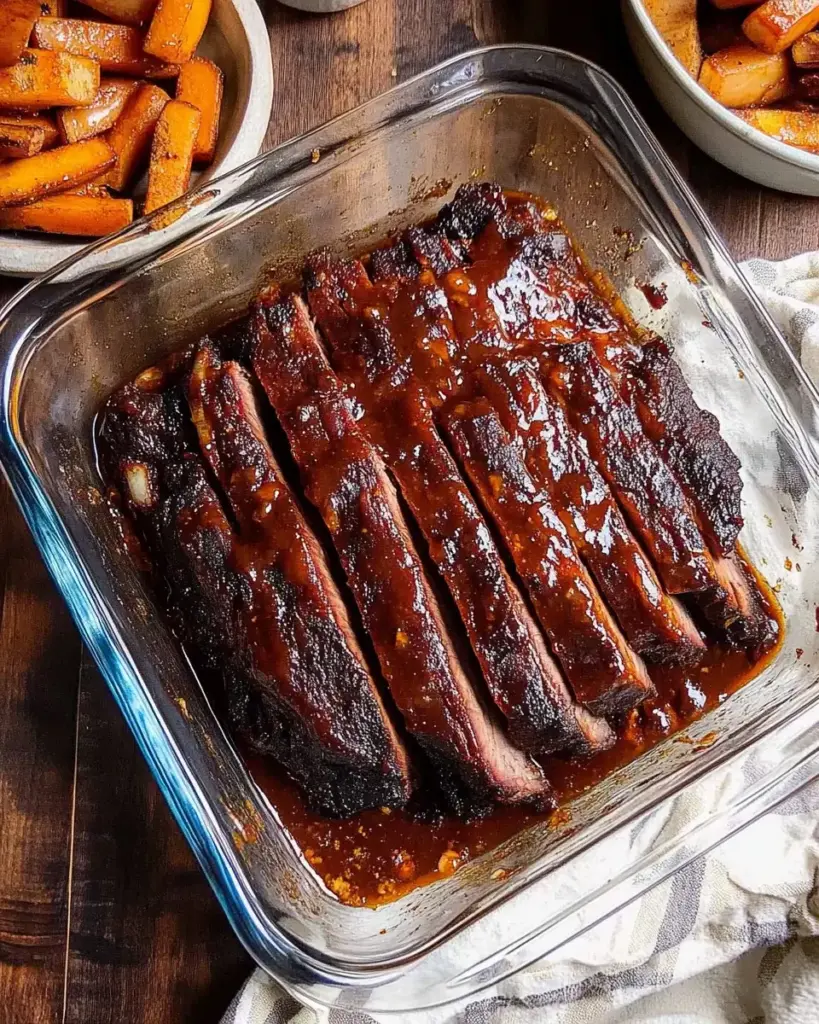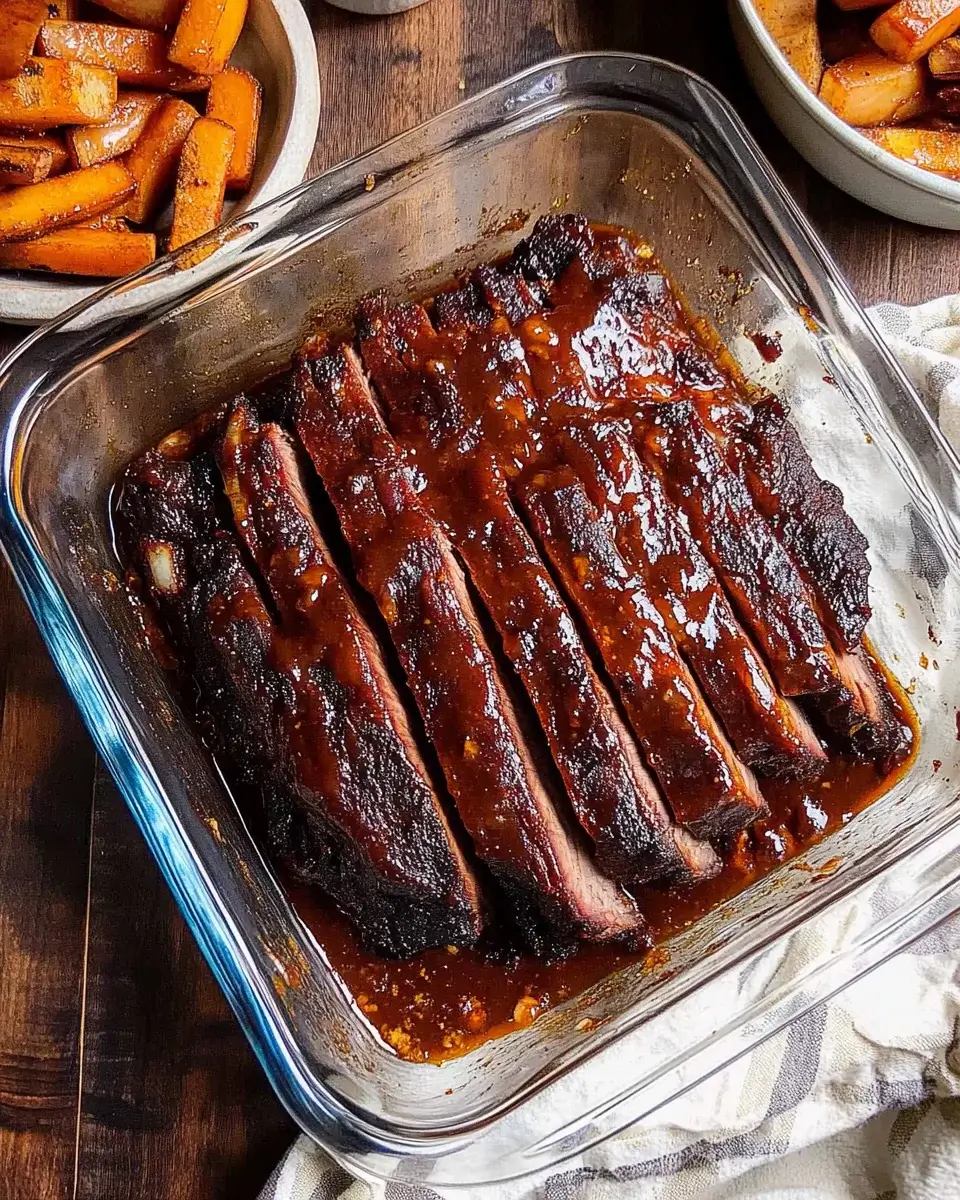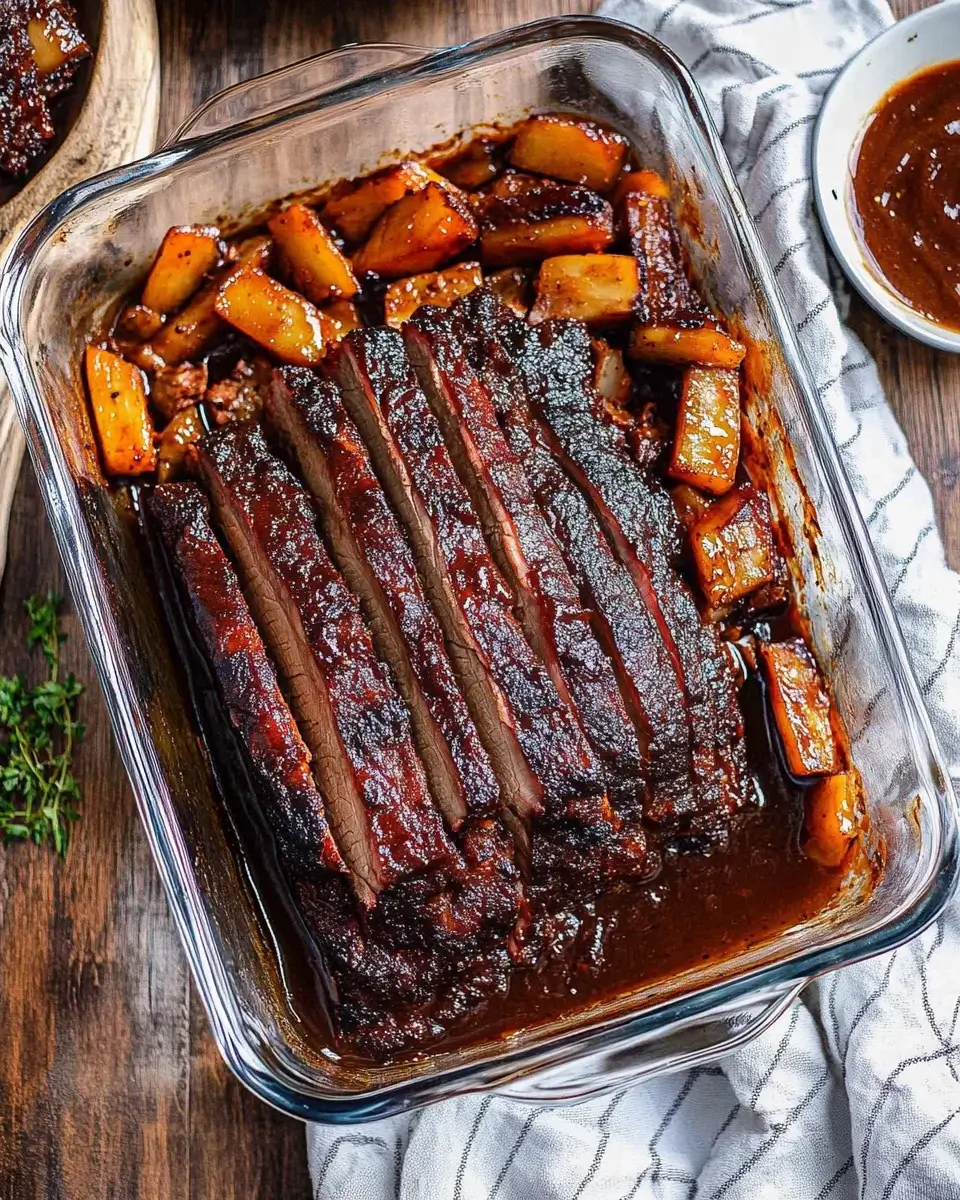Slow-Roasted Barbecue Brisket Recipe is a true delight for meat lovers. This dish is not just a meal; it’s an experience that brings family and friends together. With its rich, smoky flavor and juicy tenderness, it’s no wonder this recipe has become a favorite at gatherings and celebrations.
What Makes This Recipe Special?
What sets this brisket recipe apart? First, it’s all about the slow cooking process. Cooking the brisket at a low temperature allows the meat to become incredibly tender. The spice rub adds a burst of flavor that seeps into every bite. Plus, the final touch of barbecue sauce caramelizes beautifully, creating a sticky, sweet glaze that’s hard to resist. This recipe is perfect for both novice cooks and seasoned chefs, making it accessible to everyone.
The History of Barbecue Brisket
Barbecue brisket has a rich history that dates back to the early days of American cooking. Originating from Texas, this dish has roots in both Mexican and Southern cuisine. Traditionally, brisket was a cut of meat that was tough and required long cooking times to become tender. Over the years, pitmasters have perfected the art of smoking and slow-roasting brisket, turning it into a beloved staple at barbecues and cookouts. Today, brisket is celebrated not just in Texas but across the United States and beyond, with each region adding its unique twist to this classic dish.
Ingredients for Slow-Roasted Barbecue Brisket Recipe
Slow-Roasted Barbecue Brisket Recipe, you’ll need a few key ingredients. Each component plays a vital role in building flavor and ensuring the brisket turns out tender and delicious. Here’s what you’ll need:
- 3 to 4 pounds beef brisket: Choose a well-marbled cut for the best flavor and tenderness.
- 2 tablespoons brown sugar: This adds sweetness and helps create a caramelized crust.
- 1 tablespoon smoked paprika: This ingredient gives the brisket a smoky flavor, enhancing the barbecue experience.
- 1 tablespoon garlic powder: Garlic powder adds depth and richness to the spice rub.
- 1 tablespoon onion powder: This complements the garlic and adds a savory note.
- 1 teaspoon black pepper: Freshly ground black pepper adds a bit of heat and flavor.
- 1 teaspoon salt: Salt is essential for enhancing all the flavors in the dish.
- 1 teaspoon cayenne pepper (optional): If you like a little kick, this will spice things up!
- 1 cup barbecue sauce: Use your favorite brand for a delicious glaze.
- 1/2 cup beef broth: This keeps the brisket moist during cooking and adds extra flavor.
Gathering these ingredients is the first step toward creating a memorable meal. Each item contributes to the overall taste and texture of the brisket, making it a dish that everyone will love. Now that you have your ingredients ready, let’s move on to the preparation steps!
Step-by-Step Preparation of Slow-Roasted Barbecue Brisket Recipe
Slow-Roasted Barbecue Brisket Recipe. Each step is crucial for achieving that tender, flavorful brisket you crave. Let’s break it down step by step!
Step 1: Preparing the Brisket
Start by taking your brisket out of the packaging. Rinse it under cold water and pat it dry with paper towels. This helps remove any excess moisture, allowing the spice rub to stick better. Next, trim any excess fat from the brisket, but leave a thin layer. This fat will melt during cooking, keeping the meat juicy and flavorful.
Step 2: Creating the Marinade
In a small bowl, combine the brown sugar, smoked paprika, garlic powder, onion powder, black pepper, salt, and cayenne pepper (if you’re using it). Mix these ingredients well to create a spice rub. This blend will add a wonderful depth of flavor to your brisket, making each bite a delight.
Step 3: Marinating the Brisket
Now it’s time to apply the spice rub. Generously coat the brisket with the spice mixture, ensuring every inch is covered. For the best flavor, consider marinating the brisket overnight in the refrigerator. This allows the spices to penetrate the meat, enhancing the overall taste. If you’re short on time, a few hours will still work wonders!
Step 4: Prepping the Oven or Smoker
Preheat your oven to 300°F. If you prefer using a smoker, set it to 225°F. Both methods will yield delicious results, but the oven is a great option for those without a smoker. Prepare a roasting pan by placing the brisket fat side up in the center. Pour the beef broth around the brisket to keep it moist during cooking.
Step 5: Slow-Roasting the Brisket
Cover the roasting pan tightly with aluminum foil. This helps trap steam, ensuring the brisket cooks evenly and becomes tender. Place the pan in the preheated oven and roast for 3 to 4 hours. You’ll know it’s done when the brisket is tender and easily pulls apart with a fork. The low and slow cooking method is key to achieving that melt-in-your-mouth texture.
Step 6: Resting the Brisket
Once the brisket is cooked, remove it from the oven. Carefully take off the foil, as steam will escape. Brush your favorite barbecue sauce generously over the top of the brisket. Increase the oven temperature to 350°F and return the brisket to the oven, uncovered, for an additional 30 minutes. This step caramelizes the sauce, creating a delicious glaze. Afterward, let the brisket rest for at least 15 minutes before slicing against the grain. This resting period allows the juices to redistribute, ensuring each slice is juicy and flavorful.
Variations of Slow-Roasted Barbecue Brisket Recipe
Slow-Roasted Barbecue Brisket Recipe is a crowd-pleaser, there are many ways to switch things up! Exploring different marinades and cooking methods can elevate your brisket experience. Let’s dive into some exciting variations!
Different Marinade Options
Marinades can transform your brisket, adding unique flavors that cater to your taste. Here are a few ideas:
- Sweet and Spicy: Combine honey, soy sauce, and a splash of hot sauce for a sweet and spicy kick.
- Herb-Infused: Use fresh herbs like rosemary and thyme mixed with olive oil and garlic for a fragrant twist.
- Citrus Zest: Add orange or lemon juice to your spice rub for a refreshing citrus flavor that brightens the dish.
- Beer Marinade: Soak the brisket in your favorite beer mixed with mustard and brown sugar for a rich, malty flavor.
Feel free to experiment with these marinades! Each one brings a different taste profile, making your brisket unique every time you cook it.
Cooking Methods: Oven vs. Smoker
When it comes to cooking your brisket, you have options! Both the oven and smoker yield delicious results, but they offer different experiences:
- Oven: The oven is a convenient choice, especially for those who may not have a smoker. It allows for controlled cooking temperatures and is easy to monitor. Plus, it’s perfect for indoor cooking, regardless of the weather!
- Smoker: Smoking the brisket adds a deep, smoky flavor that many barbecue enthusiasts love. Cooking at a low temperature for several hours allows the meat to absorb the smoke, resulting in a tender and flavorful brisket. If you have a smoker, this method is worth trying!
Whichever method you choose, you’ll end up with a delicious brisket that’s sure to impress. So, gather your ingredients and get ready to enjoy a fantastic meal!
Cooking Note for Slow-Roasted Barbecue Brisket Recipe
Slow-Roasted Barbecue Brisket Recipe requires patience and attention to detail. The key to a perfect brisket lies in understanding the cooking process and making adjustments as needed. Here are some important notes to keep in mind while preparing your brisket:
- Temperature Matters: Always use a meat thermometer to check the internal temperature of the brisket. Aim for around 195°F to 205°F for optimal tenderness. This temperature allows the collagen in the meat to break down, resulting in a juicy and flavorful brisket.
- Resting is Crucial: After cooking, let the brisket rest for at least 15 minutes. This step is essential as it allows the juices to redistribute throughout the meat. If you skip this step, you may end up with dry slices.
- Adjust Cooking Time: Cooking times can vary based on the size of your brisket and your oven’s accuracy. Always check for tenderness rather than relying solely on time. If it’s not tender yet, give it more time in the oven.
- Foil Technique: When covering the brisket with foil, ensure it’s tightly sealed. This helps trap moisture and steam, which is vital for achieving that melt-in-your-mouth texture.
- Experiment with Flavors: Don’t hesitate to tweak the spice rub or barbecue sauce to suit your taste. Adding different spices or sauces can create a unique flavor profile that your family and friends will love.
By keeping these cooking notes in mind, you’ll be well on your way to mastering the art of slow-roasting brisket. Enjoy the process, and remember that great food takes time and care!
Serving Suggestions for Slow-Roasted Barbecue Brisket Recipe
Slow-Roasted Barbecue Brisket Recipe is ready, it’s time to think about how to serve it! The right side dishes can elevate your meal, making it even more enjoyable. Plus, there are creative ways to use any leftovers, ensuring nothing goes to waste. Let’s explore some delicious options!
Best Side Dishes to Pair
When it comes to pairing side dishes with brisket, you want options that complement its rich flavors. Here are some fantastic choices:
- Coleslaw: A crunchy, tangy coleslaw adds a refreshing contrast to the smoky brisket. The coolness of the slaw balances the richness of the meat.
- Macaroni and Cheese: Creamy mac and cheese is a classic comfort food that pairs perfectly with brisket. The cheesy goodness makes every bite delightful!
- Grilled Vegetables: Seasonal grilled vegetables, like zucchini and bell peppers, add color and nutrition to your plate. Their smoky flavor complements the brisket beautifully.
- Potato Salad: A creamy potato salad is another great option. It’s filling and adds a nice texture to your meal.
- Cornbread: Sweet cornbread is a Southern favorite that goes hand-in-hand with barbecue. Its sweetness balances the savory flavors of the brisket.
These side dishes not only enhance the meal but also create a well-rounded dining experience. Feel free to mix and match based on your preferences and what you have on hand!
Creative Ways to Serve Leftovers
Leftover brisket is a treasure! There are many creative ways to enjoy it beyond just reheating. Here are some fun ideas:
- Brisket Tacos: Shred the leftover brisket and serve it in warm tortillas with your favorite toppings like salsa, avocado, and cilantro. It’s a tasty twist!
- Brisket Sandwiches: Pile slices of brisket on a bun with coleslaw and barbecue sauce for a delicious sandwich. It’s perfect for lunch or a casual dinner.
- Brisket Chili: Chop the brisket and add it to a pot of chili for a hearty meal. The smoky flavor will enhance the chili, making it even more satisfying.
- Brisket Hash: Dice the brisket and sauté it with potatoes, onions, and peppers for a flavorful breakfast hash. Top it with a fried egg for extra goodness!
- Brisket Pizza: Use the brisket as a topping for pizza. Add barbecue sauce, cheese, and your favorite veggies for a unique and delicious pie.
These ideas will help you make the most of your leftovers, ensuring that every bite is just as enjoyable as the first. Get creative and have fun with your brisket!

Tips for Perfecting Your Slow-Roasted Barbecue Brisket Recipe
Slow-Roasted Barbecue Brisket Recipe, a few tips can make all the difference. From selecting the right cut of meat to maintaining the perfect cooking temperature, these insights will help you create a brisket that’s tender, flavorful, and unforgettable. Let’s explore these essential tips!
Choosing the Right Cut of Brisket
The cut of brisket you choose plays a significant role in the final outcome of your dish. Here are some key points to consider:
- Flat vs. Point Cut: Brisket comes in two main cuts: the flat and the point. The flat cut is leaner and cooks evenly, while the point cut has more marbling and fat, making it juicier. For a balance of flavor and tenderness, consider using a whole packer brisket, which includes both cuts.
- Marbling Matters: Look for brisket with good marbling. The fat within the meat melts during cooking, keeping it moist and flavorful. A well-marbled brisket will yield a more tender result.
- Freshness is Key: Always choose fresh brisket from a reputable butcher or grocery store. Check the sell-by date and look for bright red color. Avoid any cuts that appear brown or have an off smell.
By selecting the right cut of brisket, you set the foundation for a delicious meal. Take your time to choose wisely, and you’ll be rewarded with a fantastic dish!
Importance of Temperature Control
Temperature control is crucial when cooking brisket. Here’s why it matters and how to manage it effectively:
- Low and Slow: The key to tender brisket is cooking it at a low temperature for an extended period. This method allows the collagen in the meat to break down, resulting in a melt-in-your-mouth texture. Aim for a cooking temperature of around 225°F to 300°F, depending on your method.
- Use a Meat Thermometer: Invest in a good meat thermometer to monitor the internal temperature of your brisket. The ideal range for a perfectly cooked brisket is between 195°F and 205°F. This ensures that the meat is tender and juicy.
- Resting Time: After cooking, let your brisket rest for at least 15 minutes before slicing. This resting period allows the juices to redistribute throughout the meat, preventing dryness and enhancing flavor.
By mastering temperature control, you’ll elevate your brisket cooking skills. Remember, patience is key, and the results will be worth the wait!
Breakdown of Time for Slow-Roasted Barbecue Brisket Recipe
Slow-Roasted Barbecue Brisket Recipe is essential for planning your cooking process. Here’s a detailed breakdown of the time you’ll need to prepare and cook this delicious dish.
Prep Time
The prep time for this recipe is relatively short, making it easy to get started. Here’s what to expect:
- Brisket Preparation: 10-15 minutes. This includes rinsing, drying, and trimming the brisket.
- Spice Rub Preparation: 5 minutes. Mixing the spices together is quick and straightforward.
- Marinating Time: 1 hour (or overnight for best results). While this isn’t active prep time, it’s important to plan for it.
In total, you can expect about 15-20 minutes of active prep time, plus additional marinating time if you choose to let it sit overnight.
Cooking Time
The cooking time is where the magic happens! Here’s how long you’ll need:
- Slow-Roasting: 3 to 4 hours. This low and slow method is crucial for achieving tender brisket.
- Caramelizing the Sauce: 30 minutes. This step adds a delicious glaze to your brisket.
Overall, the cooking time will take approximately 3.5 to 4.5 hours, depending on the size of your brisket and your oven’s accuracy.
Total Time
When you combine the prep and cooking times, here’s the total time you’ll need:
- Total Active Time: 15-20 minutes (not including marinating).
- Total Cooking Time: 3.5 to 4.5 hours.
- Total Time (including marinating): 4.5 to 24 hours, depending on whether you marinate overnight.
Slow-Roasted Barbecue Brisket Recipe without any stress. Just remember, the longer you let it marinate, the more flavorful your brisket will be!
Nutritional Information for Slow-Roasted Barbecue Brisket Recipe
Slow-Roasted Barbecue Brisket Recipe is essential for making informed choices about your meals. This dish is not only delicious but also provides a good balance of nutrients. Here’s a breakdown of the key nutritional components per serving:
Calories
Each serving of this flavorful brisket contains approximately 350 calories. This makes it a hearty option for dinner, especially when paired with nutritious side dishes. The calorie count can vary slightly based on the specific ingredients and portion sizes you use, but it remains a satisfying choice for meat lovers.
Protein
One of the standout features of brisket is its high protein content. Each serving provides around 30 grams of protein. Protein is essential for building and repairing tissues, making it a vital part of a balanced diet. Enjoying this brisket can help you meet your daily protein needs, especially when served alongside protein-rich sides.
Sodium
The sodium content in this recipe is approximately 800 milligrams per serving. While sodium is necessary for various bodily functions, it’s important to monitor your intake, especially if you’re watching your salt consumption. To reduce sodium levels, consider using low-sodium beef broth and barbecue sauce. This way, you can enjoy the rich flavors of the brisket while keeping your health in check.
Slow-Roasted Barbecue Brisket Recipe while maintaining a balanced diet. Remember, moderation is key, and pairing this dish with fresh vegetables or whole grains can enhance its nutritional value even further!
FAQs about Slow-Roasted Barbecue Brisket Recipe
How long should I marinate the brisket?
Marinating the brisket is a great way to enhance its flavor. Ideally, you should marinate it for at least 1 hour. However, for the best results, consider marinating it overnight in the refrigerator. This allows the spices to penetrate the meat deeply, resulting in a more flavorful brisket. If you’re short on time, even a quick 30-minute marinade can still add some nice flavor!
Can I use a different cut of meat?
Yes, you can use different cuts of meat if brisket isn’t available. Cuts like chuck roast or beef shoulder can work well, but keep in mind that they may require different cooking times. These cuts are also tougher and benefit from slow cooking, just like brisket. The key is to ensure that the meat is well-marbled, as this will help keep it juicy and tender during the cooking process.
What is the best way to store leftovers?
To store leftover brisket, first let it cool to room temperature. Then, wrap it tightly in plastic wrap or aluminum foil, or place it in an airtight container. Store it in the refrigerator for up to 3-4 days. If you want to keep it longer, consider freezing it. Wrap the brisket well and place it in a freezer-safe bag. It can last for up to 3 months in the freezer. When ready to eat, thaw it in the refrigerator overnight and reheat gently.
How do I know when the brisket is done?
The best way to check if your brisket is done is by using a meat thermometer. Aim for an internal temperature of 195°F to 205°F. At this temperature, the collagen in the meat breaks down, making it tender and juicy. Additionally, you can test for tenderness by inserting a fork into the meat; it should pull apart easily. If it feels tough, give it more time in the oven!
Conclusion on Slow-Roasted Barbecue Brisket Recipe
Slow-Roasted Barbecue Brisket Recipe is a fantastic dish that brings warmth and joy to any gathering. With its tender texture and rich flavors, it’s sure to impress your family and friends. The slow cooking method allows the spices to meld beautifully, creating a mouthwatering experience that’s hard to forget.
Whether you’re a seasoned cook or just starting out, this recipe is approachable and rewarding. By following the steps outlined, you can create a brisket that rivals those found in the best barbecue joints. Remember, the key is patience—allowing the meat to cook slowly ensures it becomes tender and flavorful.
As you explore different marinades and cooking methods, don’t hesitate to make this recipe your own. Each variation can bring a new twist to the classic dish, keeping your meals exciting and fresh. Plus, with the tips provided, you’ll be well-equipped to tackle any challenges that may arise during the cooking process.
Slow-Roasted Barbecue Brisket Recipe is not just about the food; it’s about creating memories around the table. Happy cooking!

Slow-Roasted Barbecue Brisket Recipe for Perfect Flavor
Ingredients
Method
- Preheat oven to 300°F (150°C). Line a roasting pan or baking dish with foil.
- Trim the brisket fat cap to about ¼-inch if needed. Pat dry.
- In a small bowl, mix the thyme, smoked paprika, black pepper, salt, onion powder, garlic powder, cayenne pepper, and cumin to create the dry rub.
- Rub the spice mixture generously over both sides of the brisket.
- Place the brisket in the prepared pan, fat side up. Drizzle with Worcestershire sauce and BBQ sauce, then spread evenly with a spatula.
- Cover the pan tightly with foil and roast for 2 hours without uncovering.
- Remove from the oven, flip the brisket, re-cover with foil, and return to the oven. Roast for another 1½ to 2 hours, or until the brisket is fork-tender.
- Transfer the brisket to a cutting board, slice against the grain, and drizzle with pan sauce before serving.
Notes
- Use a meat thermometer to ensure the brisket reaches around 190–205°F internally for optimal tenderness.
- Let the brisket rest for 10–15 minutes before slicing to retain juices.
- Leftovers make excellent sandwiches, tacos, or wraps the next day.
- For extra smoky flavor, use a smoked BBQ sauce or add a few drops of liquid smoke.


